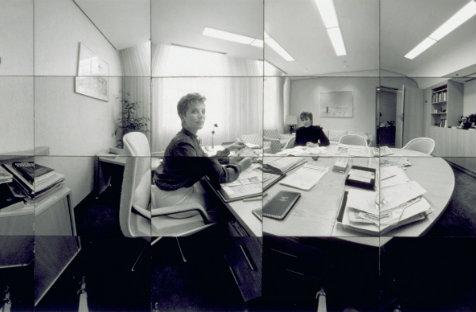There are no ‘first ladies’ in the conventional sense in the First ladies exhibition at the National Portrait Gallery – no Margaret Whitlam or Janette Howard. The exhibition in the Gallery’s smallest space showcases 26 images of prominent women over the past 100 years, drawn from the permanent collection.
The National Portrait Gallery’s youth may make it difficult to compete with the larger state and national galleries but it has its advantages in a collection that better reflects contemporary values. Most portrait galleries the world over under-represent women. Australia’s collection is about one third portraits of women – still far off equality, but given the society it represents, not bad at all.
The selection featured in First ladies is an interesting window into the lives and roles of women considered worthy of portraiture, their context greatly enhanced by hanging along a well-considered timeline which provides historical context.
It is a small but effective exhibition, bookended by two powerfully contrasting images. The first is of a cluster of suffragettes demonstrating in London, among them among them Vida Goldstein who in 1903 became the first woman in the British Empire to contest a national parliamentary seat.
The other image is a striking colour photographic portrait of a younger Julia Gillard, taken in 2006. Photographer Robin Sellick placed the frank and hyper-realistic face against a neon violet suburban shed, a powerful juxtaposition which gives a sense of the youthful idealism of the then prime-minister-in-waiting.
Gillard is not technically the final image – that honour goes to a more recent corporate portrait of Gail Kelly – but Sellick’s portrait is a superb work which certainly captures the contrast artistically as well as politically that the exhibition illustrates.
Between Goldstein and Gillard the exhibition is spread chronologically along two parallel walls. The first half is mainly conventional portraits of more historical than artistic value.
These are names every Australian should know but many probably don’t. Jessie Street, who founded the Social Hygiene Association for family planning and maternal health in 1906, is represented by an unremarkable but important oil painting by Jerrold Nathan.
For sheer beauty, there is a Max Dupain image of the supermodel before supermodels, June Dally-Watkins.
Nora Heyson, the first female Archibald prize winner and first female official war artist, who served in New Guinea and Borneo during World War II, appears in a flat-faced and unrevealing modernist self-portrait.
Other works include two images of tennis players – an oil portrait of Margaret Court by William Dargie and a lovely Ern McQuillan photograph of Evonne Goolagong Cawley.
The second side of the exhibition is more aesthetically interesting. It is dominated by a huge Type C photograph of Cathy Freeman, produced by Montalbetti +Campbell. It is an extraordinary work, intensely close and gritty, its sepia surface dissolving into a powerful portrait of determination.
There is also an interesting photo montage of Ita Buttrose, taken during her tenure as Editor of The Daily Telegraph by John Williams.
First ladies is a good tasting for both the strengths and weaknesses of the National Portrait Gallery’s collection. It is still a fledgling collection but it can draw together an exhibition that is both important and interesting.
We hope many of the school trips which haunt Canberra take the time to visit this little exhibition and recommend anyone in the area considers dropping in.
Rating: 3 stars out of 5
First ladies: Significant Australian Women 1913 – 2013
National Portrait Gallery, Canberra
1 February – 16 June





